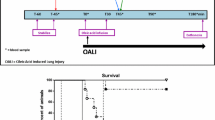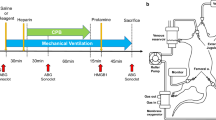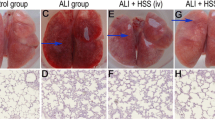Abstract
Objective
Activation of fibrinolysis is implicated in the development of vascular injury in certain lung injuries. It has yet to be reported that activation of plasmin is involved in extravasation caused by oleic acid (OA). We examined whether or not plasmin is involved in pulmonary extravasation by OA.
Design
Prospective trial.
Setting
University laboratory.
Subjects
A total of 78 guinea pigs (498.9±10.6 g).
Interventions
Evans blue (EB) was administered to anesthetized guinea pigs. Subsequently four protocols were followed: (1) After 1 min, 60 μl/kg of OA was injected. Perfusion was performed 30, 60 or 90 min after OA injection to wash out intravascular EB. (2) After 1 min, 15, 30 or 60 μl/kg of OA was injected. (3) Tranexamic acid (TA) (2 g/kg) or saline was administered 30 min before OA (15 μl/kg) injection. (4) Diphenhydramine hydrochloride (2.9 mg/kg) or saline was administered 7 min before OA (15 μl/kg) injection.
Measurement and results
Except in protocol 1, the chest cavity was opened 90 min after OA injection. Perfusion was then performed. Airway was separated into four parts from trachea to distal bronchus. EB was extracted from the tissues and measured. OA caused an extravasation throughout airways in a time-and dose-dependent manner. Extravasation was more conspicuous in peripheral tissues. TA significantly attenuated extravasation, while diphenhydramine hydrochloride did not.
Conclusions
It is suggested that plasmin, but not histamine, is involved in extravasation by OA. Inhibition of plasmin can be an effective strategy for treatment of this kind of lung injury.
Similar content being viewed by others
References
Eiermann GJ, Dickey BF, Thrall RS (1983) Polymorphonuclear leukocyte participation in acute oleic-acid-induced lung injury. Am Rev Respir Dis 128: 845–850
Johnson A, Tahamont MV, Kaplan JE, Malik AB (1982) Effect of pulmonary embolization induced by thrombin vs. fibrin microaggregates on lung fluid balance. J Appl Physiol 52: 1565–1570
Haynes JB, Hyers TM, Giclas PC, Frank JJ, Petty TL (1980) Elevated fibrin(ogen) degradation products in the adult respiratory distress syndrome. Am Rev Respir Dis 122: 841–847
Derks CM, Derks DJ (1977) Embolic pneumopathy induced by oleic acid. Am J Pathol 87: 143–158
Luterman A, Manwaring D, Curreri PW (1977) The role of fibrinogen degradation products in the pathogenesis of the respiratory distress syndrome. Surgery 82: 703–709
Manwaring D, Thorning D, Curreri PW (1978) Mechanism of acute pulmonary dysfunction induced by fibrinogen degradation product D. Surgery 84: 45–54
Moriuchi H, Yuizono T (1994) Oleic acid-induced PaO2 decrease model for primary screening of drugs for hypoxemia: Effect of tranexamic acid and procaterol hydrochloride on the decrease in PaO2. Folia Pharmacol Jpn 103: 27–36
Moriuchi H, Yuizono T (1995) Pentoxifylline prevents a decrease in arterial oxygen tension in oleic acid-induced lung injury. Crit Care Med 23: 357–364
Tokuyama K, Yokoyama T, Morikawa A, Mochizuki H, Kuroume T, Barnes PJ (1993) Attenuation of tachykinin-induced airflow obstruction and microvascular leakage in immature airways. Br J Pharmacol 108: 23–29
Evans TW, Chung KF, Rogers DF, Barnes PJ (1987) Effect of platelet-activating factor on airway vascular permeability: possible mechanisms. J Appl Physiol 63: 479–484
Maciver AG, Metcalfe IL, Possmyer F, Harding PGR, Passi RB (1977) Alternation of surfactant chemistry in experimental hemorrhagic pancreatitis. J Surg Res 23: 311–314
Haliton RW, Hustead RF, Peltier LF (1964) Fat embolism: The effect of particulate embolism on lung surfactant. Surgery 56: 53–56
Clark DA, Nieman GF, Thompson JE, Paskanik AM, Rockhar JE, Bredenberg CE (1987) Surfactant displacement by meconium free fatty acids: An alternative explanation for atelectasis in meconium aspiration syndrome. J Pediatr 110: 765–770
Johnson A, Tahamont MV, Malik AB (1983) Thrombin-induced lung vascular injury: role of fibrinogen and fibrinolysis. Am Rev Respir Dis 128: 38–44
Saldeen T (1979) The microembolism syndrome. A review. In: Saldeen T (ed) The microembolism syndrome. Almguist and Wiksell International, Stockholm, pp 7–44
Selig WM, Patterson CE, Henry DP, Rhoandes RA (1986) Role of histamine in acute oleic acid-induced lung injury. J Appl Physiol 61: 233–239
Abelli L, Nappi F, Subissi A, Manzini S, Giachetti A (1992) Effect of mequitamium iodide (LG 30435) on airway microvascular leakage in the guinea-pig. Pulmonary Pharmacol 5: 137–141
Idell S, Koenig KB, Fair DS, Martin TR, MacLarty J, Maunder RJ (1991) Serial abnormalities of fibrin turnover in evolving adult respiratory distress syndrome. Am J Physiol 261: L240-L248
Idell S, Peterson BT, Gonzalez KK, Gray LD, Bach R, Fair DS (1988) Local abnormalities of coagulation and fibrinolysis and alveolar fibrin deposition in sheep with oleic acid-induced lung injury. Am Rev Respir Dis 138: 1282–1294
Allard MF, Doerschuk CM, Brumwell ML, Belzberg A, Hogg JC (1988) Oleic acid-induced lung injury in rabbits: effect of fibrinogen depletion with Arvin. J Appl Physiol 64: 920–928
Jefferies AL, Fung D, Mullen JBM (1991) Fibrinogen depletion and control of permeability in oleic acid lung injury. Am Rev Respir Dis 143: 618–624
Brinder AS, Nakahara K, Ohkuda K, Kageler W, Staub NC (1979) Effect of heparin or fibrinogen depletion on lung fluid balance in sheep after emboli. J Appl Physiol 57: 147–153
Rabbani LE, Johnstone MT, Rudd MA, Devine P, George D, Loscalzo J (1993) PPACK attenuates plasmin-induced changes in endothelial integrity. Thromb Res 70: 425–436
Weiland JE, Davis WB, Holter JF, Mohammed JR, Dorinsky PM, Gadek JE (1986) Lung neutrophils in the adult respiratory distress syndrome. Am Rev Respir Dis 133: 218–225
Lo SK, Ryan TJ, Gilboa N, Lai L, Malik AB (1989) Role of catalytic and lysine-binding sites in plasmin-induced neutrophil adherence to endothelium. J Clin Invest 84: 793–801
Sasaki H (1994) Effect of tranexamic acid on neutrophil chemotaxis, phagocytosis and reactive oxygen species generation in vitro. Jpn Pharmacol Ther 22: 1429–1435
Author information
Authors and Affiliations
Rights and permissions
About this article
Cite this article
Moriuchi, H., Arai, I. & Yuizono, T. Tranexamic acid attenuates oleic-acid-induced pulmonary extravasation. Intensive Care Med 21, 1003–1008 (1995). https://doi.org/10.1007/BF01700662
Received:
Accepted:
Issue Date:
DOI: https://doi.org/10.1007/BF01700662




